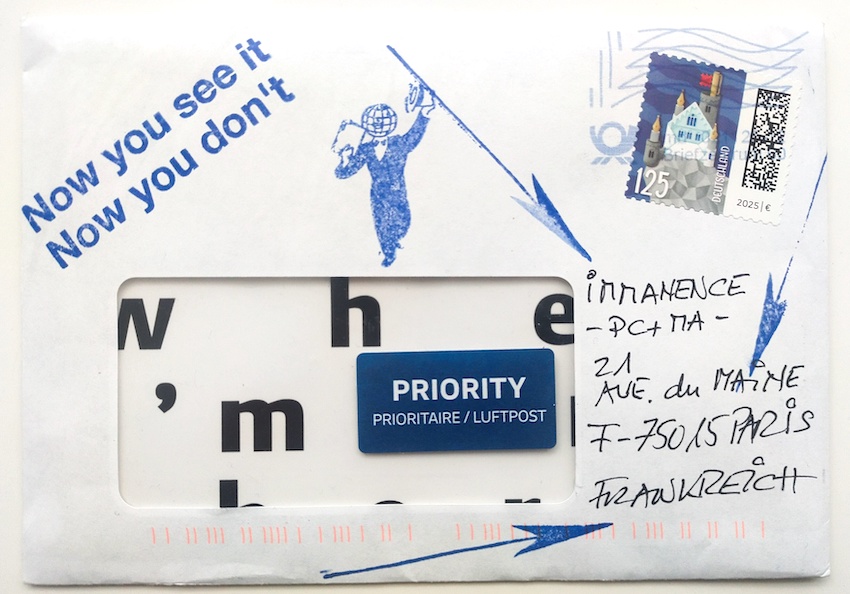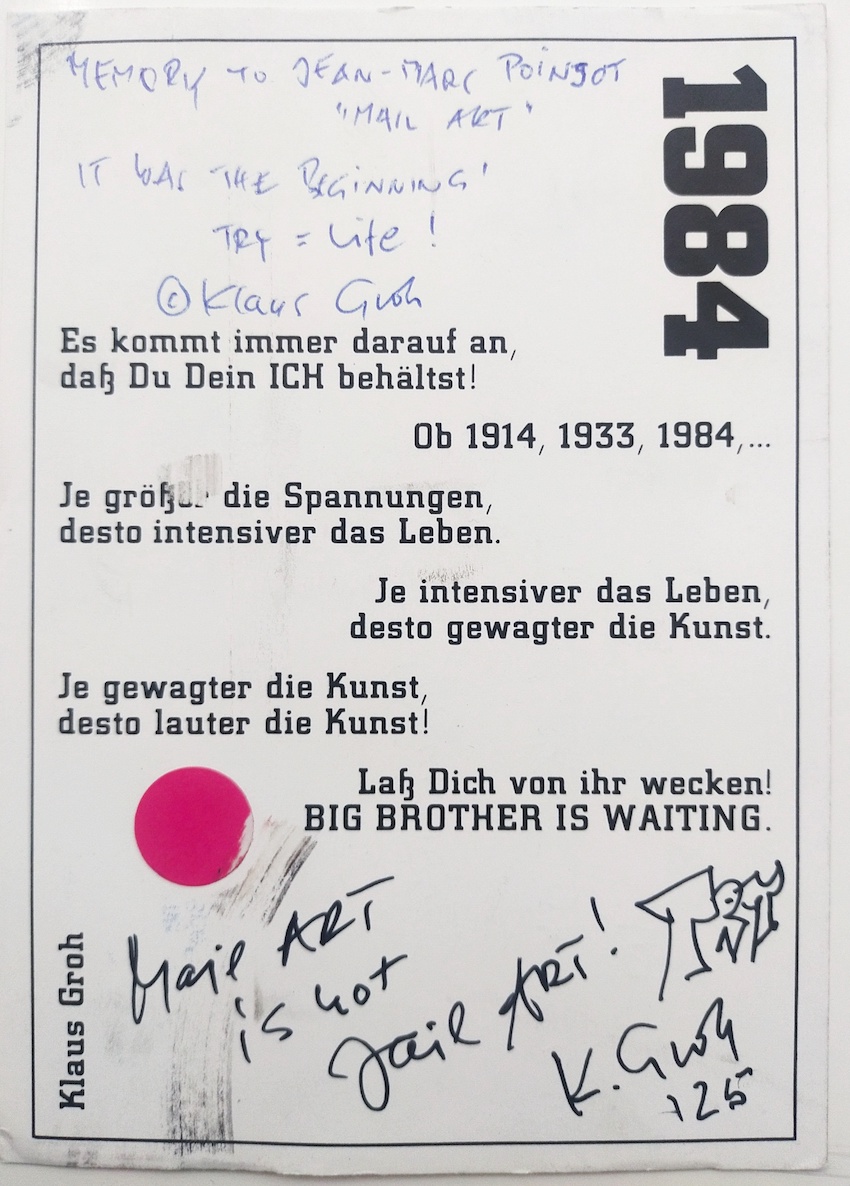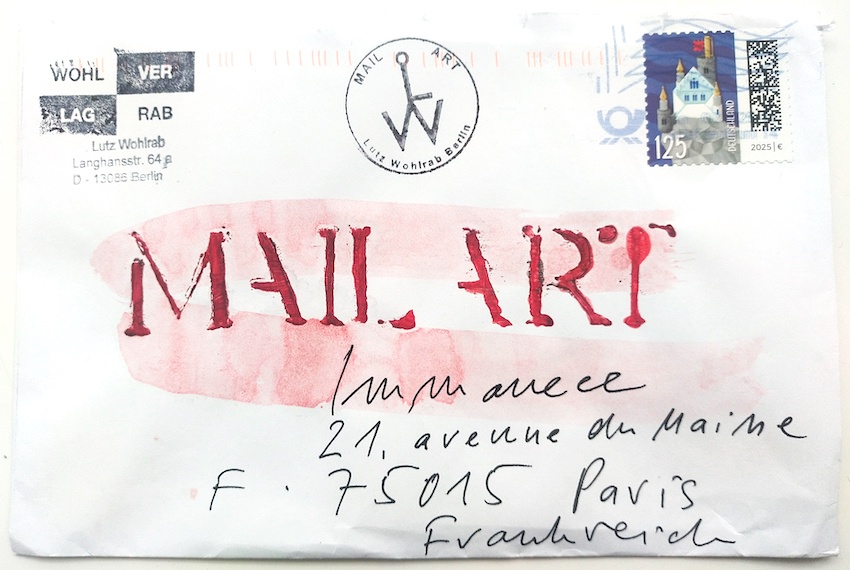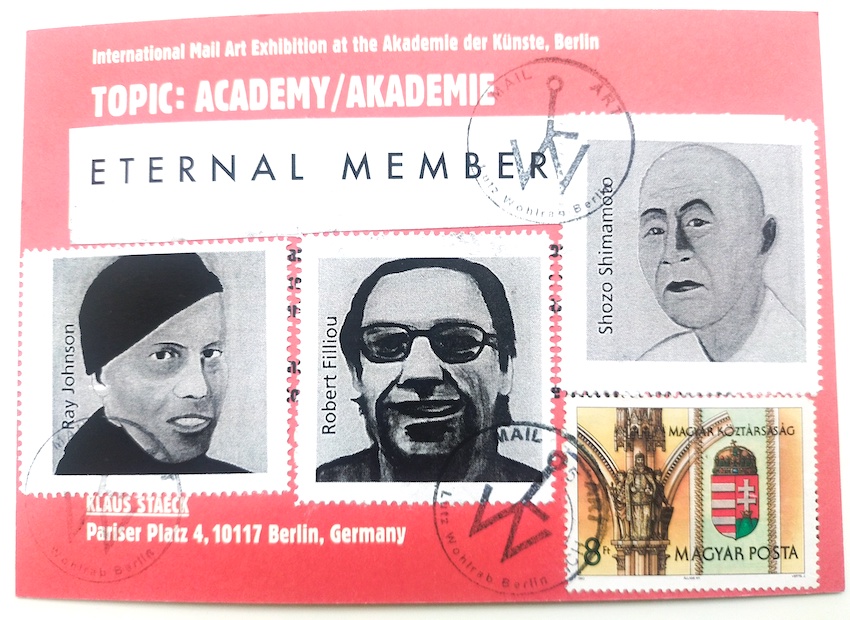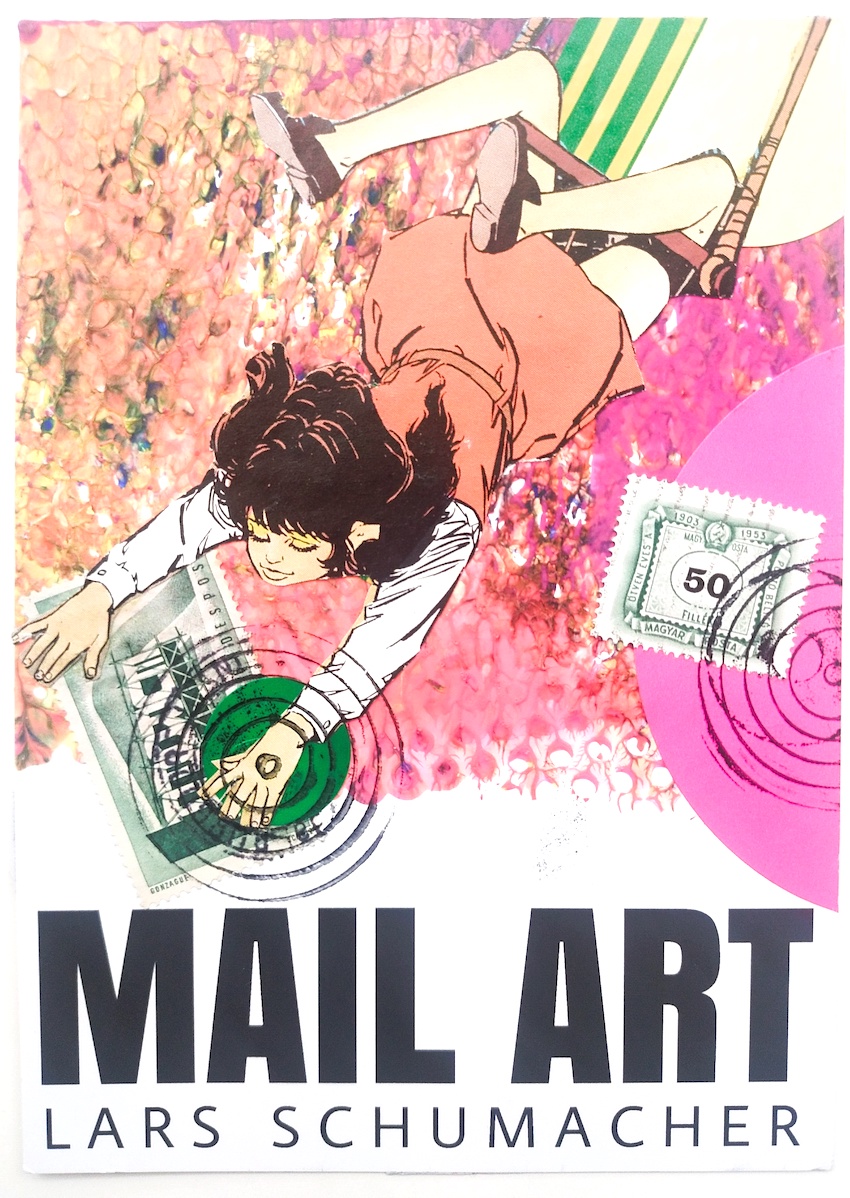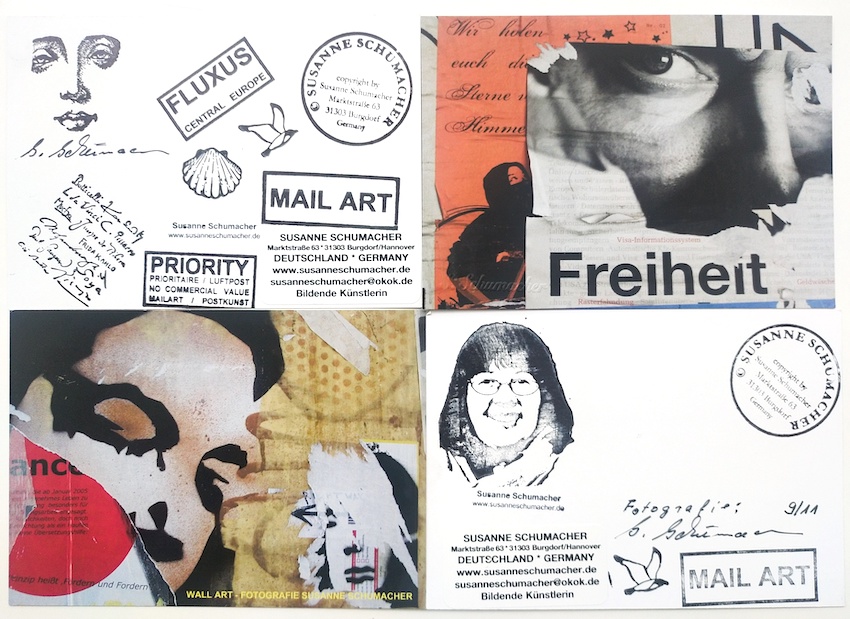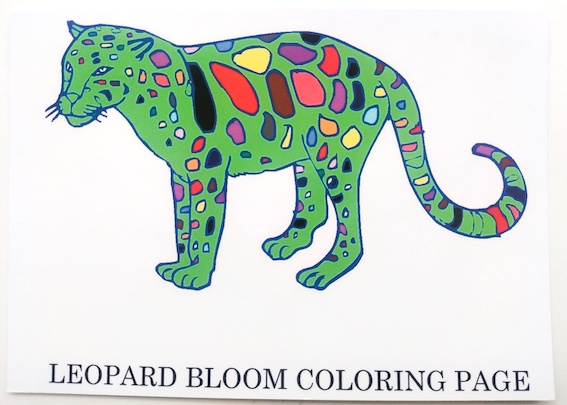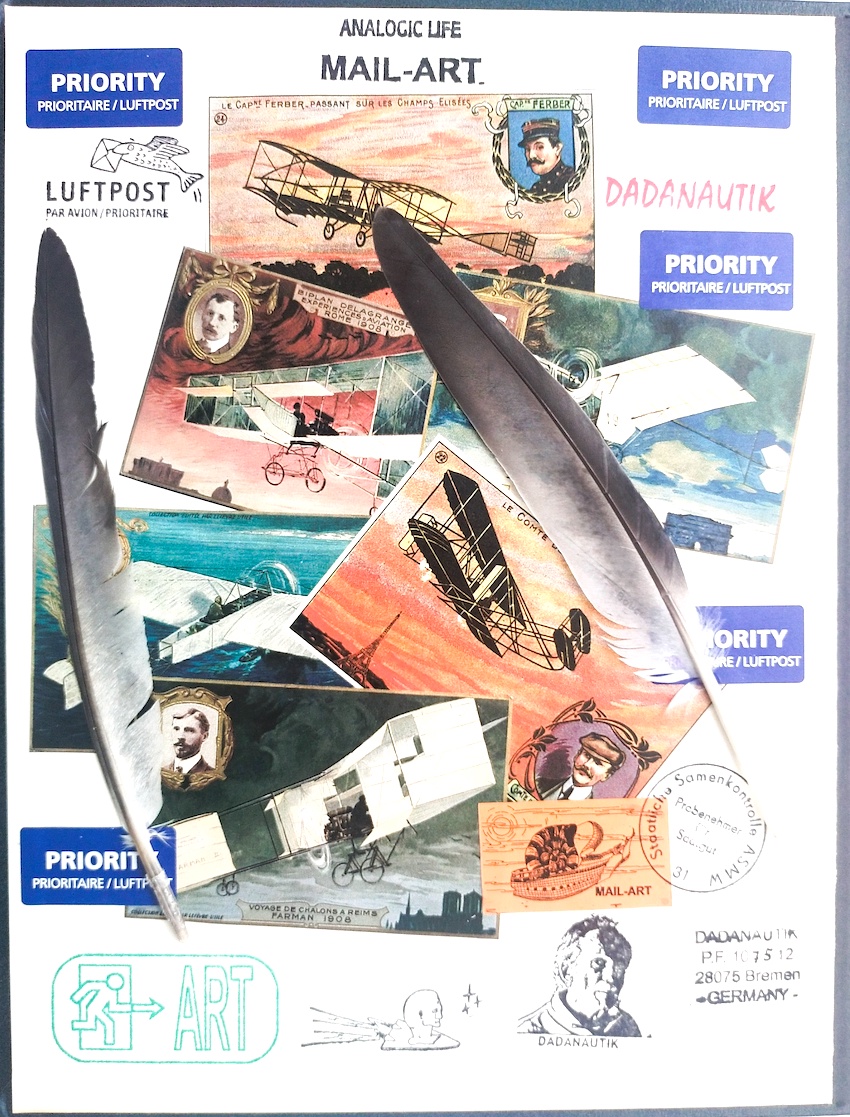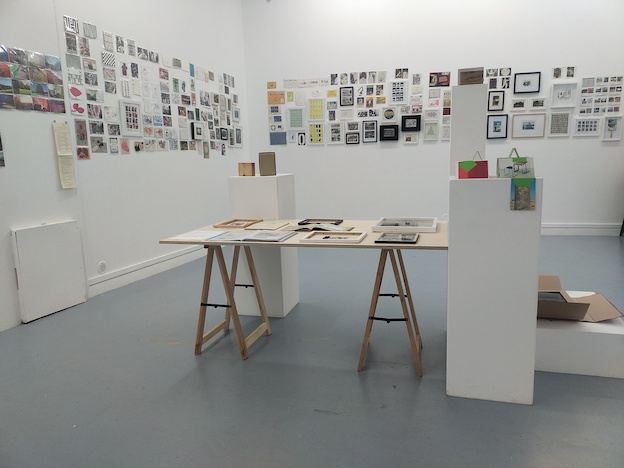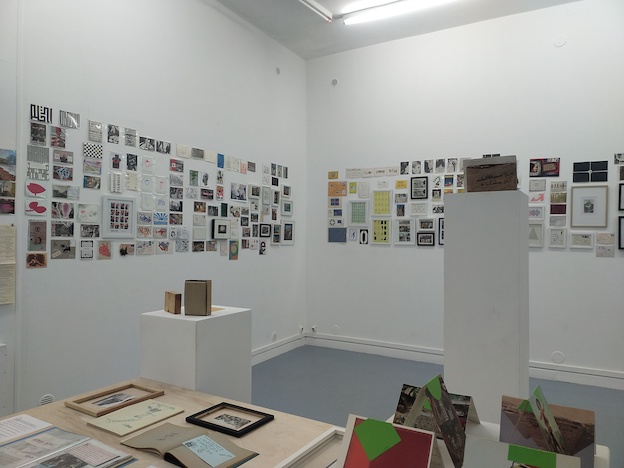les expositions — 2025
CARTES POSTALES et MAIL-ART
Du 22 novembre au 19 décembre 2025
Cette exposition est dédiée au grand poète grec Démosthène Agrafiotis.
Cette exposition rassemble à la fois une sélection de cartes postales réalisées par des artistes ainsi qu’un ensemble d’œuvres et d’envois reçus spécialement pour l’événement.
L’exposition est évolutive et grandie au fur et à mesure des envoies, plus de 500 œuvres sont présentées de plus de 250 artistes issus de plus de trente pays.
See English text below
La liste des artistes s’allonge au fur et à mesure des que nous recevons.
Avec/ With : Martine Aballéa, Peter Abajkovics, Anne Abou, Frédéric Acquaviva, Démosthène Agrafiotis, Fernando Aguiar, Jean-Michel Alberola, Christian Alle, Elisabeth Amblard, Franck Ancel, Giovanni Anceschi, AooA, Karel Appel, Argillia, Arman, Atelier Populaire, Enrico Baj, Sabela Baña, Melanie Bäreis, Vittore Baroni, Paul Bazin, Francesca Bella, Valérie Belin, John Bennett, Ottmar Bergmann, Pedro Bericat, Joseph Beuys, Daphné Bitchatch, Caroline Bittermann, Julien Blaine, Sarah Bodman, Christian Boltanski, Mario Borillo, Jean-François Bory, Daniel C. Boyer, BP (Renaud Layrac, Frédéric Pohl, Richard Bellon), Hans Braumüller, George Brecht, Theo Breuer, Marcel Broodthaers, Camille Bryen, Dmitry Bulatov, Alfonso Caccavale, Agnès Caffier, Bernard Calet, Angela Caporaso, Isabelle Caraés, Bettina Carl, Christiane Carré, Orianne Castel, Guglielmo Achille Cavellini, Cozette de Charmoy, Florence Chevalier, Roberta Chiarella, Bruno Chiarlone, Paella Chimicos, Henri Chopin, Mario Cobas, Bob Cobbin, Joel Cohen, Michel Collet, William Copley, Michel Corfou, Periklis Costopoulos, Réjean F. Côté (Circulaire 132), Jean-Claude Courval, DADANAUTIK, Daniel Daligand, Renata Danicek, Hanne Darboven, Jean Degottex, Ma Desheng, Erik Dietmann, DOC(K)S (revue), Paul Dorn, Ferruccio Dragoni, Jerry Dreva, Sved Uwe Dressler, François Dufrêne, Jean-Jacques Dumont, Leif Elggrenn, Öyvind Fahlström, Bartolomé Ferrando, Bernadette Février, Luc Fierens, Robert Filliou, Ken Friedman, Thorsten Fuhrmann, Marco Furia, György Galántai, Christophe Galatry, Jakob Gautel, Antonia Gennimata, Paul-Armand Gette, Gilbert & George, Max Ghj, Liliane Giraudon, John Giorno, Michel Giroud, Ferdinand Glenk, Yves Gobart, Susan Gold, Agnieszka Gosk-Zaleska, Guillaume Goutal, Klaus Groh, Géraldine Guilbaud, Brion Gysin, Leo Hainzl, Richard Hamilton, Sten Hanson, Raoul Hausmann, Bernard Heidsieck, John Held Jr., Karl Horst Hödicke, Risto Holopainen, Joël Hubaut, Joseph W. Huber, Alice Hutchins, Olivier-Franck Huyghe, Dorothy Iannone, Katrin Jaquet, Gerald Jatzek, Daniel Jauslin, Jef Aérosol, Birger Jesch, Holly Johnson, Ray Johnson, Asger Jorn, Ana Jotta, Detlef Kappis, Jason Karaïndros, Alison Keenan, Ellsworth Kelly, Katia Kelm, Johannes Klaucke, Alison Knowles, Arthur Køpcke, Jannis Kounellis, Serafine Christine Kratze, Frederico Kreth, Zlatko Krstevski, Inès P. Kubler, Hans Jürgen Küster, Susanna Lakner, François Lagarde, Safia Laghrour, Matthieu Laurette, Jean-Jacques Lebel, Stéphane Lecomte, William Lee, Jean Le Gac, Jean-Claude Lefevre, Ben Leenen, Michael Leigh, Bob Lens, Siggi Liersch, Eloise Lifton, Eni Lis, Andre Lisangi, Virginie Loreau, Gaëlle Lucas, Henri Maccheroni, Jackson Mac Low, George Maciunas, Brice Marden, Richard Martel, Olive Martin, M. Chat, Katerina Mandarik, Chris Marker, Annette Messager, MH//ANTIPODE, Monica Michelotti, Wanda Mihuleac, Stephan J. Mitterwierser, Susanne Mitterwieser, Alex Mlynarcik, Mohammed (aka Plinio Mesciulam), Sabine Mohr, Malcom Morley, Côme Mosta-Heirt, Martine Mougin, Tania Mouraud, Massimo Mori, Valérie Mréjen, Gabriele Müller, Christa Näher, Gerald Naar, Keiichi Nakamura, Seigne Ndiaye, Seth Nicemail, Boris Nieslony, Katerina Nikoltsou, Andrew Maximilian Niss, Guttorm Nordö, Zorica Obradovic, Jürgen O. Olbrich, José Oliveira, Pauline Oliveros, Mathilde Ollivier, Yoko Ono, Jeremie Otternbach, Asma Ounine, Cumhur Okay Özgör, Fergana Kocadoru Özgör, Marco Pachetti, Clemente Padin, Nam June Paik, Bogdan Pavlovic, Claude Pélieu, Rémy Pénard, Ben Patterson, Pierre Petit, Ségolène Perrot, Horvath Piroska, Bruno Pierozzi, Pete Pistol, PLG, Hugo Pontes, Morgane Porcheron, Plonk & Replonk, Rittiner & Gomez, Gabriel Pomerand, Hugo Pontes, Hervé Quenolle, Andre Radke, Jérôme Rappanello, Serge-Henri Rodin, Yvonne Roeb, Robic Roesz, Marcia Rosenberger, Dieter Rot(h), Francis van Rossem, Edward Ruscha, Robert Ryman, Carmela Sarcina, Abderrazak Sarenco, Antonio Sassu (Gruppo Sinestetico), Roberto Scala, Michel Seuphor, Takahachi Shohachiro, Lars Schumacher, Susanne Schumacher, Schmuck (Martha Hellion et Felipe Ehrenberg), Renate Schweizer, Daniela Scurtulescu, Sorin Scurtulescu, Esther Ségal, Tanabe Shin, Adrian Sorin Sinescu, Judith Skolnick, Christine Smilovici, Snappy, Alain Snyers, Spike Spence, Daniel Spoerri, Klaus Staeck, Giovanni e Renata StraDA DA, Cannelle Tanc, Paul-André Tanc, Irina Tall, Ulrich Tarlatt, Romain Théobald, Miroslav Tichy, Tofu, Stephen Tomasko, Tonelli, Roland Topor, Lois Torre, Endre Tót, Horst Tress, Richard Tuttle, Ben Vautier, Michel Della Vedova, Valentine Verhaeghe, Martine Viale, Christophe Viard, Jacques de la Villeglé, Frédéric Vincent, Yoshi Wada, Eric Watier, Robert Watts, Rainer Wieczorek, Ruth Wolf-Rehfeldt, Henri van Zanten, Bettina Weiss, Tom Westermann, Lutz Wohlrab, Gil Wolman, Reid Wood, Tamara Wyndham, Dana Wyse, Max Wyse, La Monte Young.
et bien d’autres/and many others.
Provenances des œuvres : Allemagne, Angleterre, Autriche, Belgique, Biélorussie, Brésil, Canada, Chine, Espagne, État-Unis, France, Grèce, Hongrie, Italie, Japon, Kénya, Macédoine, Maroc, Norvège, Pays-Bas, Phillipines, Portugal, Roumanie, Russie, Sénégal, Serbie, Suède, Suisse, Tchéquie, Turquie, Uruguay.
Toutes les œuvres reçues seront exposées et documentées.
À l’heure du numérique, des envois massifs et des échanges instantanés par email, nous proposons une exposition consacrée à la carte postale et au mail art. Objets de mémoire, de transmission et de création, les cartes postales ont longtemps servi de support à de nombreux artistes d’avant-garde.
L’exposition présentera un large éventail de cartes postales d’artistes, témoignant de la diversité des approches et des époques. Par ailleurs, un appel à participation sera lancé : durant une période définie, tous les artistes qui le souhaitent pourront nous envoyer une ou plusieurs cartes postales. Celles-ci seront exposées sans sélection ni jury, dans un esprit d’ouverture et d’inclusion.
Le mail art, notamment durant certaines périodes de répression politique, a offert une alternative libre et inventive à la censure. L’enveloppe ou la carte devenaient alors supports d’expression, parfois subversifs, souvent poétiques.
Comme le formule Maïten Bouisset : le mail art est-il un art pour initiés ou un art initié ? Après les pionniers des années 60 et 70, une nouvelle génération d’artistes a prolongé cette pratique, en exploitant les multiples possibilités offertes par les techniques d’impression.
La carte postale, tout comme le mail art, permet d’appréhender l’art contemporain de manière plus accessible. Elle relie les pratiques artistiques à une expérience universelle : celle d’envoyer ou de recevoir une carte postale. Cette approche populaire ouvre une porte vers l’art, à la fois intime, collective et spontanée.
>>>>>>>>>>>>>>>>>>>>>>>>>>>>>>>>>>>>>>>>>>>>>>>>>>>>>
The list of artists grows longer as we receive more.
This exhibition brings together a selection of postcards created by artists, as well as a collection of artworks and submissions received specifically for the event.
The exhibition is constantly evolving and growing as more submissions arrive ; over 500 works are currently on display from more than 250 artists from over thirty countries.
Origins of the works :
Austria, Belarus, Belgium, Brazil, Canada, China, Czechia, England, France, Germany, Greece, Hungary, Italy, Japan, Kenya, Macedonia, Morocco, Netherlands, Norway, Philippines, Portugal, Roumania, Russia, Senegal, Serbia, Spain, Sweden, Switzerland, Türkiye, United States, Uruguay.
All the works received will be exhibited and documented.
In this digital age of mass mailings and instant email exchanges, we are proposing an exhibition dedicated to the postcard and to mail art. Objects of memory, communication, and creation, postcards have long served as a medium for many avant-garde artists.
The exhibition will present a wide range of artists’ postcards, reflecting the diversity of approaches and eras. In addition, an open call will be launched : during a set period, all artists who wish to participate will be able to send us one or several postcards. These will be exhibited without selection or jury, in a spirit of openness and inclusion.
Mail art, especially during certain periods of political repression, offered a free and inventive alternative to censorship. The envelope or postcard thus became a medium of expression — sometimes subversive, often poetic.
As Maïten Bouisset puts it : Is mail art an art for initiates or an initiated art ? After the pioneers of the 1960s and 1970s, a new generation of artists has continued this practice, making use of the many possibilities offered by printing techniques.
The postcard, like mail art, allows contemporary art to be approached in a more accessible way. It connects artistic practices to a universal experience — that of sending or receiving a postcard. This popular approach opens a doorway into art that is at once intimate, collective, and spontaneous.
